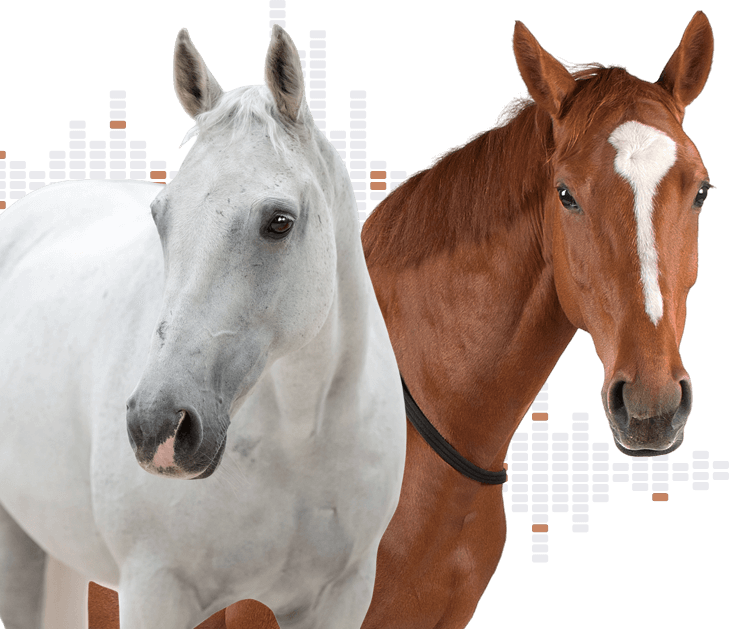Horses
Popular Sire Effect
You may have noticed that all horses in the 2025 Kentucky Derby are descendants of Secretariat. From a genetic perspective, this is an example of a relatively common trend in breeding: breeding mares to top-performing stallions. These sires are often exceptional in some way and therefore preferred by breeders, who hope their qualities will be passed on to their offspring. However, these breeding decisions inevitably shape the entire breed population, not always for the better. Let’s discuss what is known as the popular sire effect.
The popular sire effect is not limited to horse breeding. It’s also an issue in cattle, dogs and other animal species whose breeding is controlled by humans. Those sires who become popular are often overused in breeding programs, their genes quickly spreading through the gene pool. The diversity of the population is therefore narrowed – overuse of one sire inevitably means excluding other high-quality, but less popular, stallions from breeding, and the sire’s genes quickly become much more frequent in the population.
This poses a significant risk because such sire may pass on not only desirable traits but also detrimental ones. Of course, this can happen with any sire or a dam. However, with the popular sires, the main problem is how quickly their influence spreads across the entire population. Without any prior consideration of the long-term effects of the sire’s genetic contribution, he may produce numerous offspring before his genetic qualities can be properly evaluated. By the time such an evaluation is possible, his genes are already widely spread, making his impact on the gene pool difficult to reverse.
For example, the Quarter Horse stallion Impressive (b. 1969, d. 1995) sired over 2000 foals during his life, including multiple world champions. However, in the 1990s, he was identified as a single source of a mutation responsible for Hyperkalemic periodic paralysis (HYPP). By the time the disease was described, thousands of animals were affected, because Impressive was – you guessed it – a popular sire. His descendants are required to be tested for the disease to be registered under the American Quarter Horse Association (AQHA), and since 2007, horses homozygous for the mutation (HYPP/HYPP or H/H) have not been accepted for registration. However, HYPP is an autosomal co-dominant disease, meaning it manifests even if the horse inherits the mutated gene from only one parent (HYPP/N, or H/N), although symptoms tend to be more severe in horses that inherit two copies of the mutation.
The cause of the disorder is a mutation in the SCN4A gene, which encodes a subunit of a skeletal muscle sodium channel. The mutation disrupts the body’s ion balance, resulting in hyperkalemia – excessive potassium in the blood – muscle tremors, paralysis, weakness and in some cases, sudden death due to cardiac arrest or respiratory failure. Horses with this mutation usually have a more muscular build and appear to be judged superior to unaffected individuals in halter classes.
Favouring only a few sires in breeding programs presents a risk, as it might backfire in the long run. A sire’s genetic contribution to the breed should be gradual and carefully monitored, as it can only be fully assessed through the characteristics of his descendants and, to some extent, genetic testing.
Whole genome sequencing can help maintain the genetic diversity of the breed while minimising the risk of inherited disorders, as it allows breeders to make informed breeding decisions, ultimately promoting healthier and more resilient horse populations. It covers all known markers for genetic diseases and, potentially, even unknown mutations that have yet to be described. It’s in the best interest of the breed to monitor positive and negative characteristics passed to the next generation, and whole genome sequencing represents a powerful tool for achieving this goal.
make your order
Order online
our process
How does it work?
Take a few steps only to uncover your horse's DNA traits and learn more about his or her health and performance markers.


Select and Submit
Take charge of your genetic exploration journey by selecting the count of horses to be analyzed and any desired optional extras. Submit your order and expect a prompt response from our team.

Receive a Collection Package
We will deliver a package directly to your doorstep. It contains everything needed for a trouble-free blood sample collection by your veterinarian. After collecting the blood sample, simply send it back to us within 24 hours following the instructions you will also receive from us.

DNA Analysis Unveiled
We will isolate the genomic DNA of your horse from the sent blood sample. In our state-of-the-art laboratory, we will perform a whole genome DNA sequencing revealing the complex genetic information of your beloved horse.

Exclusive Data Delivery to Your Hands
We ensure the utmost privacy and exclusivity as we courier all the invaluable data and meticulously crafted reports directly to your hands. Of course, we remain at your disposal in case of questions!

EquineTest Online Storage
Once a year, if you wish, we will update your horse’s DNA sequencing report to reflect the current knowledge of horse’s markers of interest. Please notice there is a fast development in this field and considering the age and expected lifetime of your horse it may be worth to run this update service regularly. It will allow you to keep up with the latest scientific findings which are carefully monitored and implemented into our reports by our team of specialists.
what people say
Testimonials
get in touch
Contact us
![]()
We are located in the Czech Republic
Equinetest is a part of SEQme, a sequencing service provider since 2012.

SEQme s.r.o., Dlouha 176, 263 01 Dobris
(+420) 602 102 790 or (+420) 608 617 352 hello@equinetest.com

 Heidelberg, Germany
Heidelberg, Germany Budweis, Czech Republic
Budweis, Czech Republic Kuwait City, Kuwait
Kuwait City, Kuwait Göteborg, Sweden
Göteborg, Sweden